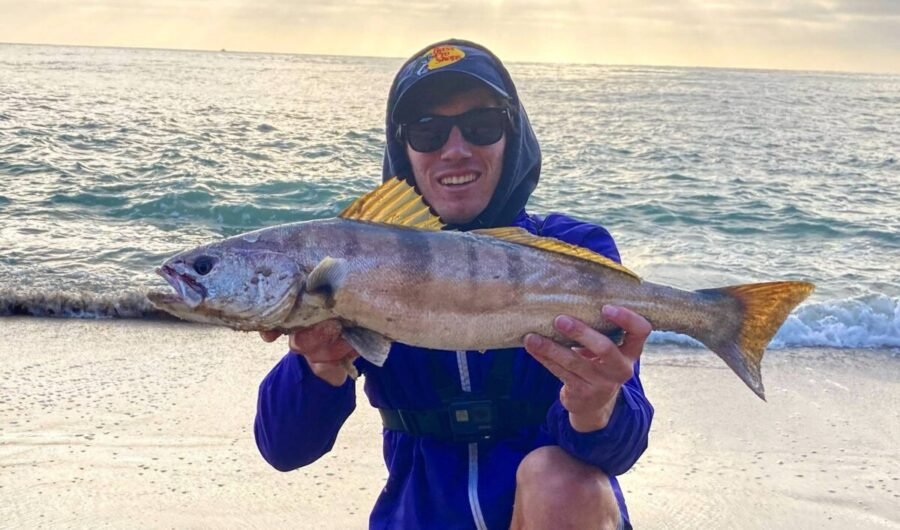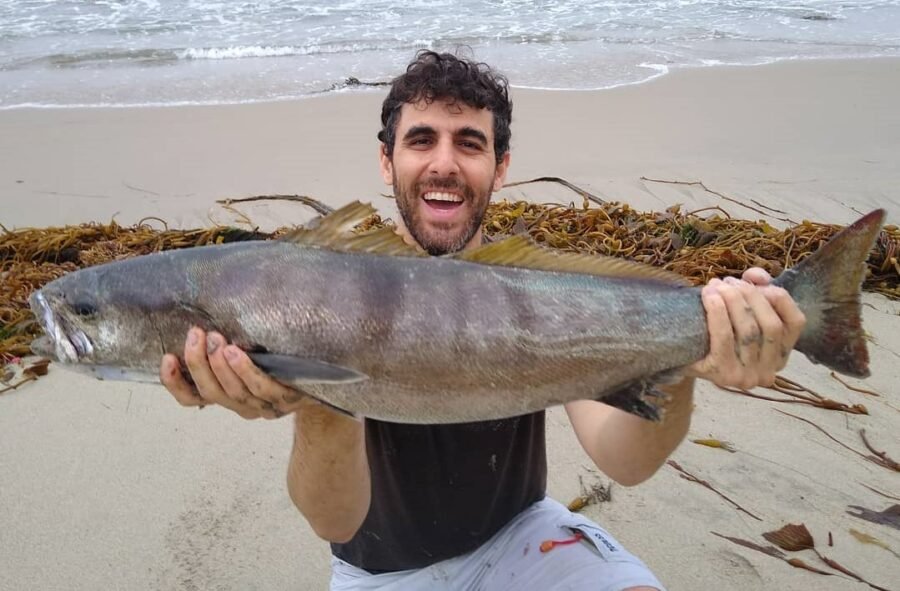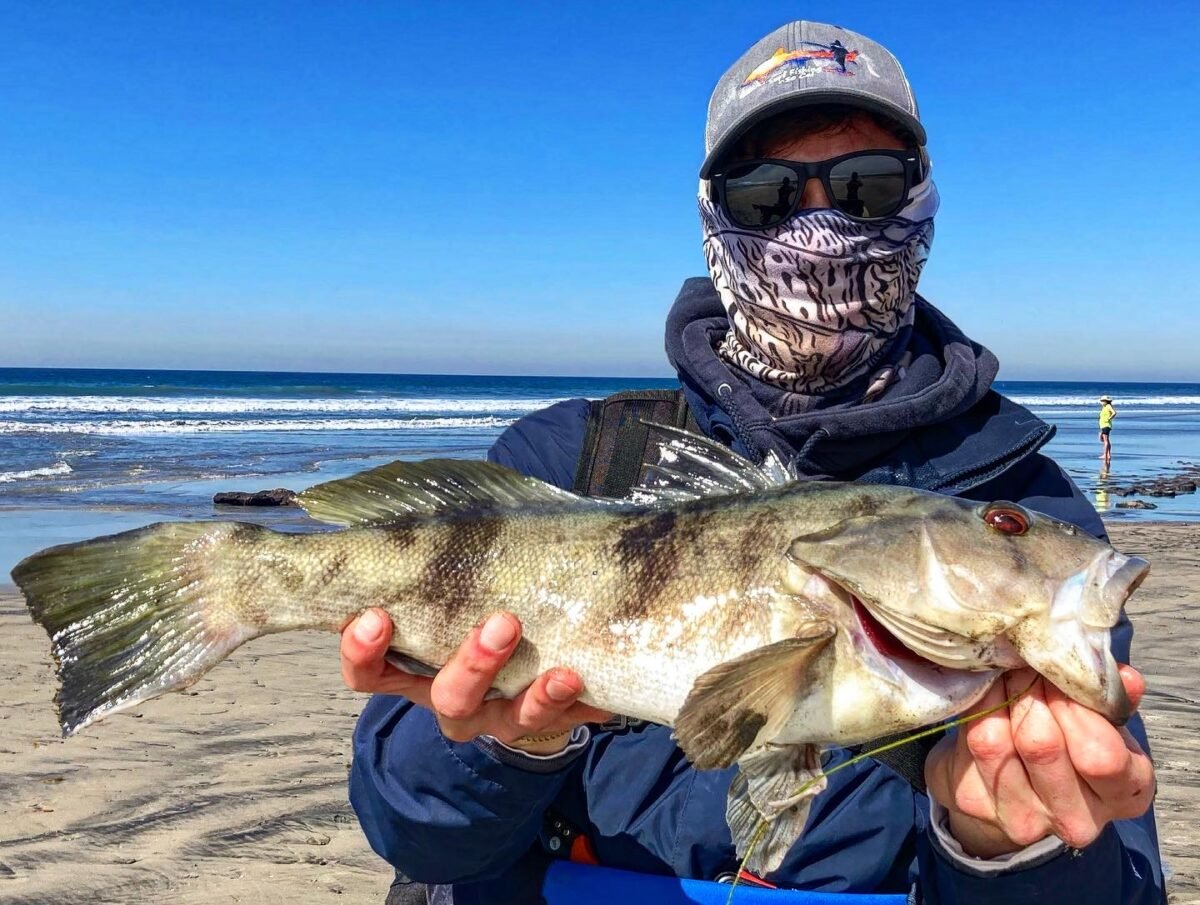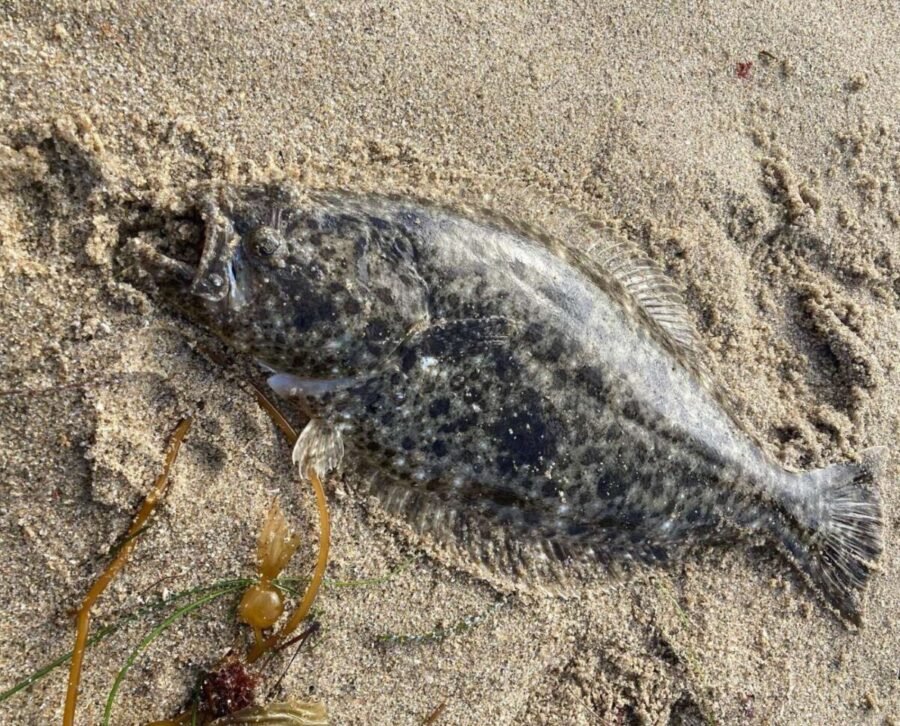Surf Fishing for White Seabass: Catching Ghosts from Shore

Can you catch white seabass from the beach? Believe it or not, you can. In this article, I’ll provide a species profile along with some information on the white seabass fishery.
| Common Names | White seabass, seabass, ghost, grey ghost, |
| Legal Limit (#) | The daily bag limit is three fish, except from March 15 through June 15 when the daily bag limit is one fish south of Point Conception. |
| Legal Size (in) | 28 inches |
| Record Size (in/lb) | 60 inches/93 pounds |
| Typical Size Range (in) | 18-30 inches (from land) |
| Fighting Strength (-/10) | 9/10 |
| Range | Magdalena Bay, Baja California – Point Conception, California |
| Habitat | rocks, reef, eel grass, kelp forests |
| Bait | 3-5-inch swimbaits and jerkbaits or similar lures |
Species
White Seabass (Atractoscion nobilis) is the largest species in the croaker family (Sciaenidae). They’re coloration is generally considered white, silver, or even “blue/grey” often with dark bars running vertically along either side. Additionally, their dorsal fin(s) will usually display a yellow tinge. Coloration in combination with their reputation to be active around grey light has earned them the nickname “Grey Ghost” or “Ghost”.
They have an elongated body with short pectoral fins and like their relatives, they are capable of producing a “croaking” noise via their abdominal muscle hitting their swim bladder.
Range
White seabass are commonly found as far south as Baja California in Magdalena Bay and as far north as Point Conception California. On few occasions, this large species of croaker has been reported as far north as Juneau, Alaska.
Habitat: Where do White Seabass Live?
Commonly found in a variety of habitats, white seabass can be found in open coastline but are most often near hard structure and vegetation like reef systems, kelp forests, and anywhere eel grass will grow along with other rock-scattered areas.
Juveniles can be found in bays and estuaries but usually spend the majority of their time in the open ocean by their 3rd year.
While they are a predatory fish, they spend the majority of their time in the lower water column. They like to hug the bottom and stay near structure for a balance of protection/shelter from predators along with increased opportunity for ambush in hunting.
Size: How Big Do White Seabass Get?
The largest white seabass recorded in California weighed in at 93 pounds and measured to 5 feet in length! While they can certainly grow upwards of 5 feet and potentially over 100 pounds in weight, the average weight and length is 20lbs and 3ft.
In regards to surf fishing for white seabass and pier fishing for white seabass, the typical catch is most often a juvenile still in it’s first couple years and usually around 20 to 26 inches and 4 to 7 pounds.
Life Span: How Long Do White Seabass Live?
The oldest white seabass caught was 28 years old and it is believed they don’t live beyond 30 years of age very often.
White Seabass Reproduction
White seabass spawning occurs from March through September close to shore, although, the vast majority of spawning occurs in the months of May through July. Fertilization occurs externally as females release the eggs (usually at night) and males release their gametes which in turn completes the fertilization process.
Diet
White seabass feed on a mix of small and large baitfish as well as squid and some invertebrates. They’ll most commonly eat sardines, mackerel, anchovy and market squid.
Predators
Given their vast range in size throughout their lifetime, white seabass outgrow many of their predators as they age. While young, other fish, sea lions and sharks are atop the list of predators of white seabass. As they become adults, most other fish are knocked off the list while sea lions and sharks remain.
Fishing Season
“The recreational fishery is open year-round but occurs primarily March through September. The daily bag limit is three fish, except from March 15 through June 15 when the daily bag limit is one fish south of Point Conception. The commercial fishery is closed between Point Conception and the U.S. and Mexico border from March 15 to June 15, except one fish may be taken, possessed, or sold by a vessel each day if taken incidental to gill and trammel net fishing operations.” (1).
Surf Fishing for White Seabass
White seabass can be caught from shore year-round but peak season for surf fishing for white seabass occurs from May through July.
Best Rods, Reels, and Lures for White Seabass Fishing
- Rod: Okuma SST-S-902HA – 1/2-2oz | 10-30lb | 9ft | H | MF
- Reel: Penn Spinfisher VI (3500 or 4500)
- Main Line: 30-pound braid
- Leader Line: 30-pound mono
- Lure Options:
- Lucky Craft FM 110 (jerkbait)
- Keitech Fat Swing Impact (4.8″) | Warbaits 0.5-ounce Weedless Jighead
- BioSpawn ExoSwim (4.75″) | Mustad KVD Grip Pin Swimbait Hook (5/0 | 1/8oz) (T Rigged)
Tips for White Seabass Fishing
My best advice to anyone looking to learn how to catch white seabass from the beach is to read Gary Kazazian’s “California Surf Fishing – The Hunt for Big Fish”.
Do your homework, spend a lot of time, grind it out, and find rocky areas with kelp, eel grass and reef. White seabass like to hang out in these areas and weedless swimbaits like the ones listed above and in the following three articles, are very helpful.
I like a slow retrieve that’s steady at times but I’m not afraid to throw some signature on it with some twitches here and there if I can feel it well. Take some time in the shallows watching how your lure moves with the different different twitches and motions you add to it and picture that during your retrieve. Envision the heck out of it! And know that if you’re in a fishy spot and your bait looks like a fish, you’ll get a hook up eventually!
Tips from Gary on Catching White Seabass from Shore

Catching white seabass in the surf is a real thrill. While perhaps the most difficult species to target from shore, the battle is second to none.
In my opinion, there are two factors that are most important when fishing for seabass in the surf: reef and deep water.
Reef and Deep Water
Reef attracts bait fish, which attracts predators. Deep channels next to reef provide opportunities for predators to ambush prey. White seabass roam these channels in search of easy feeding opportunities. In my book, you’ll read about how I use Google Earth as a tool to initially identify reef and potential zones. As helpful as it is, it will not show you exactly what’s there as conditions inevitably change over time.
Finding these deep channels requires in person scouting. When you get to the beach, what you want to look for is where shallow reef abruptly transitions to deep water. The more blue the water, the better. That bottom of that deep water can be sand or a combination of reef and sand. The most important feature is a dramatic shift in depth, which is ideal structure for seabass trapping bait fish that don’t have an easy escape route.
Lures for White Seabass Fishing
Oftentimes, the presence of reef necessitates a weedless presentation to prevent snags. By weedless, I mean something like a 4.8″ Keitech or Biospawn swimbait paired with a weighted hook like the Owner Beast. While there are other factors that increase the chances of catching seabass, this is a solid foundation for catching white seabass in the surf. Good luck!

White Seabass Population Decline and Replenishment Program
White seabass were heavily overfished in prior years and their population size declined drastically in the late 1900’s. Since then, researchers and conservationists have worked hard to rekindle the population size.
Off the coast of Southern California, we now have hatcheries and research centers raising juvenile white seabass to replenish and grow the population back to health prior to the effects of overfishing. I encourage you guys to check out the following links.
“Michael Shane says there are two main reason the replenishment program is in place. ‘That has been the impetus of this program to replenish stock we have over fished or have lost valuable habitat,’ said Shane.
Covering the cost of the program are those benefiting the most. He said that legislation went into effect in the 80’s that has fishermen in Southern California pay an additional license that supports the program.
Those dollars go to the Department of Fish and Wildlife who contract Hubbs SeaWorld. To keep the program healthy, new adult White Seabass will make the return trip. ‘After spending a couple of months in quarantine they will be brought inside to provide a fresh gene pool to the tanks here,’ said Shane.” – CBS 8
References:



Enjoyed the read Nice, once again……….thanks for sharing
Thank you!